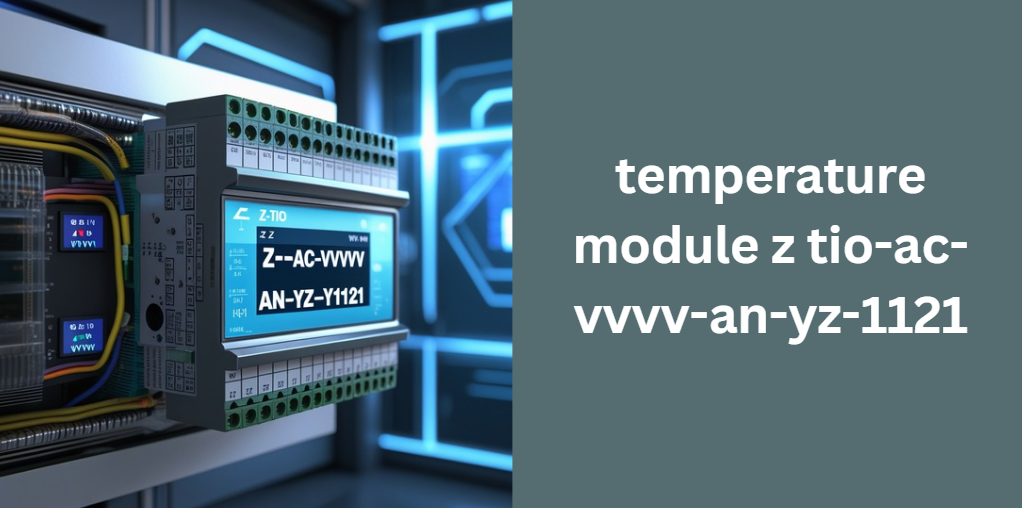The Ultimate Comprehensive Guide to the temperature module z tio-ac-vvvv-an-yz-1121
Temperature control plays a critical role in ensuring product quality and safety in industrial applications. With rapidly evolving technology, devices like the temperature module z tio-ac-vvvv-an-yz-1121 have become essential. This guide explains the importance of precise temperature monitoring and control, highlights the unique aspects of this module, and sets the stage for a detailed exploration of its features and benefits.
Product Overview
The temperature module z tio-ac-vvvv-an-yz-1121 is part of a sophisticated family of modular controllers from RKC Instrument Inc. Known for its reliability and advanced functionality, this module is engineered to meet the rigorous demands of modern industrial applications. Its design allows integration into a wide range of systems, including PLCs and HMIs, making it a versatile tool for both temperature and process control.
Historically, the Z-TIO series has evolved to incorporate multi-channel inputs, versatile outputs, and robust communication interfaces. Today, the temperature module z tio-ac-vvvv-an-yz-1121 is used in industries ranging from manufacturing and process control to energy management, providing a reliable means to monitor and adjust temperatures accurately.
Key Features and Benefits
The temperature module z tio-ac-vvvv-an-yz-1121 offers a host of features that set it apart from competitor products. Its advanced design includes multi-channel input capabilities, allowing the use of thermocouples, RTDs, and other sensor types. It delivers outputs in multiple formats such as relay contact, voltage pulse for SSRs, DC current/voltage, triac, and open collector outputs, ensuring compatibility with various systems.
For example, some of the standout benefits include:
- Multi-Channel Input Capability: The module supports different sensor types and provides flexible input options.
- Versatile Output Options: With various output methods available, it caters to a broad range of control scenarios.
- High Accuracy and Speed: Featuring a fast sampling cycle (approximately 0.25 seconds) and high measurement accuracy (around ±0.2% plus one digit), it ensures precise control.
- Robust and Reliable Design: Built to operate on a 24 VDC power supply and withstand industrial environmental conditions (operating temperature from –10°C to +55°C), it meets stringent safety and EMC standards.
- Seamless Communication Integration: With RS-485 and other fieldbus options, the module can be easily integrated into larger control systems.
Technical Specifications
Understanding the technical specifications is crucial for proper integration and performance assessment. Below is a table summarizing key specifications for the temperature module z tio-ac-vvvv-an-yz-1121:
| Parameter | Specification |
|---|---|
| Input Types | Thermocouples (K, J, R, etc.), RTDs (Pt100, JPt100), DC voltage/current |
| Sampling Time | 0.25 seconds (approx.) |
| Measurement Accuracy | ±0.2% of displayed value plus one digit |
| Output Options | Relay contact, Voltage pulse, DC current/voltage, Triac, Open collector |
| Power Supply | 24 VDC (Rating) |
| Operating Temperature | –10°C to +55°C |
| Compliance Standards | UL, cUL, EN61010-1, EN61326-1 |
This table provides a quick reference to assess whether the module meets the requirements of your application.
Installation and Wiring
Installing the temperature module z tio-ac-vvvv-an-yz-1121 correctly is essential for optimal performance. Begin by ensuring that all power is disconnected and that safety precautions are in place. The module is designed to be mounted on a DIN rail or directly in a control panel, depending on your system’s requirements.
A typical installation process might involve the following steps:
- Preparation:
Verify that all necessary tools and wiring components are available. Ensure that your work area is safe and compliant with local electrical codes. - Mounting:
Attach the module to a DIN rail or panel using the provided mounting brackets. Ensure that there is sufficient space (usually a minimum of 50 mm above and below the module) for proper ventilation and maintenance. - Wiring:
Connect the sensor inputs, power supply, and output wires according to the wiring diagram provided by RKC Instrument Inc. It is important to route signal wires away from power lines to minimize electrical noise. - System Integration:
If integrating with external devices such as a PLC or HMI, connect the communication cables (typically RS-485) to enable host communication.
A simple wiring diagram table may look like this:
| Connection Type | Connector/Terminal | Notes |
|---|---|---|
| Power Supply | Terminal 1 (+24 VDC), Terminal 2 (–24 VDC) | Supply power to one module; all joined modules receive power |
| Sensor Inputs | Input terminals labeled TC, RTD, IN | Follow the sensor type specifications |
| Outputs | OUT1, OUT2, etc. | Choose relay, voltage, or current outputs as required |
| Communication | RS-485 terminals | For integration with PLC/HMI systems |
Configuration and Setup
After installation, configuring the temperature module z tio-ac-vvvv-an-yz-1121 is the next important step. Initial configuration typically involves using dedicated software tools provided by RKC, such as PROTEM2 or ZEAL2, to calibrate sensor inputs and set up output parameters.
The configuration process includes:
- Initial Calibration: Adjust the sensor input range and verify accuracy.
- Communication Settings: Set the RS-485 or other fieldbus communication parameters to match your system requirements.
- Parameter Adjustments: Configure control parameters (such as PID settings) for optimal performance based on your application’s needs.
- Firmware Updates: If applicable, check for firmware updates to ensure that the module operates with the latest features and security enhancements.
Applications and Use Cases
The versatility of the temperature module z tio-ac-vvvv-an-yz-1121 makes it suitable for a wide range of industrial applications. It is commonly used in process control systems where precise temperature regulation is crucial, such as:
- Manufacturing Processes: Controlling temperature in ovens, furnaces, or chemical processing units.
- Energy Management: Monitoring and adjusting temperatures in HVAC systems and renewable energy installations.
- Laboratory Testing: Providing accurate temperature control for experimental setups.
- Automated Production Lines: Integrating with PLCs and HMIs for real-time monitoring and control.
Real-world case studies have shown that when properly integrated, this module can significantly enhance system reliability and performance while reducing downtime.
Maintenance and Troubleshooting
Regular maintenance and prompt troubleshooting are vital to ensure long-term performance of the temperature module z tio-ac-vvvv-an-yz-1121. Routine checks should include:
- Visual Inspections: Check for any signs of wear or damage on the wiring and connectors.
- Performance Testing: Periodically test sensor accuracy and output performance.
- Error Code Analysis: Utilize diagnostic tools to interpret error messages and take corrective action.
- Documentation Review: Refer to the user manuals and technical guides provided by RKC for detailed troubleshooting procedures.
A short troubleshooting checklist might include:
- Verify power supply stability.
- Check all wiring connections.
- Ensure proper calibration of sensor inputs.
- Restart the module and monitor communication signals.
Competitive Analysis
In comparing the temperature module z tio-ac-vvvv-an-yz-1121 with competitor products, several key advantages emerge. Unlike many rival modules that may offer limited input/output options or slower response times, this module provides a highly versatile solution with multi-channel capabilities, rapid sampling, and high precision. Furthermore, its robust design and adherence to strict safety standards make it an ideal choice for demanding industrial environments.
A summary comparison table could look like this:
| Feature | temperature module z tio-ac-vvvv-an-yz-1121 | Competitor A | Competitor B |
|---|---|---|---|
| Multi-channel input | Yes | Limited | Limited |
| Output versatility | Relay, Voltage Pulse, DC, Triac, Open Collector | Fewer options | Fewer options |
| Sampling Time | 0.25 sec | 0.5 sec | 0.5 sec |
| Measurement Accuracy | ±0.2% + 1 digit | ±0.5% | ±0.5% |
| Industrial Design & Standards | UL, cUL, EN61010-1, EN61326-1 | Basic | Basic |
Frequently Asked Questions (FAQs)
What design innovations set the temperature module z tio-ac-vvvv-an-yz-1121 apart from previous models?
This module introduces a refined compact design that optimizes space usage while maintaining high channel density. Its enhanced modularity and improved mounting options allow for easier scalability and integration into modern industrial systems.
How does the module manage power fluctuations in challenging industrial environments?
The design includes built-in circuitry to handle voltage variations, ensuring stable operation even during brief power surges or dips. This robust power management contributes to consistent performance and longevity in demanding settings.
Is the module compatible with Internet of Things (IoT) platforms, and how is data security ensured during remote communication?
Yes, the module can be integrated with IoT systems by leveraging its RS-485 communication interface along with modern adapters. Advanced encryption protocols and secure register mapping practices help safeguard data as it travels between the module and cloud-based monitoring systems.
What customization options are available for tailoring the module to specific industrial applications?
Users can fine-tune parameters such as sensor calibration ranges, output configurations, and control algorithms (including PID and heat/cool modes) to suit unique process requirements. Additional software tools allow for custom firmware settings and integration with diverse fieldbus networks.
How do the built-in diagnostic and self-testing features contribute to proactive system monitoring?
The module incorporates comprehensive self-diagnostic routines that continuously monitor sensor inputs and output responses. Early detection of irregularities triggers alerts, enabling maintenance teams to address issues before they escalate and ensuring improved system reliability.
Conclusion
In summary, the temperature module z tio-ac-vvvv-an-yz-1121 by RKC Instrument Inc. is a powerful and versatile solution for modern industrial temperature control. Its multi-channel inputs, varied output options, fast response, and robust design make it stand out in the competitive landscape.
By following proper installation, configuration, and maintenance practices, this module can significantly enhance system efficiency and reliability. Whether you are looking to integrate advanced temperature control in manufacturing or process applications, this guide has provided the comprehensive insights needed to maximize the benefits of your system.
Additional Resources and References
For further reading and technical details, consider reviewing the official documentation from RKC Instrument Inc., including downloadable manuals and CAD files. Industry white papers, case studies, and online forums dedicated to industrial automation can also provide valuable insights. Always ensure you refer to the latest safety guidelines and technical standards relevant to your installation.
Recommended posts
Comprehensive Guide to ejf5oopd – In-Depth Analysis, Applications, and Future Trends
LiteTile Plus 8×8 Kit with Sarge’s Rigging Gear – The Ultimate Guide
The Ultimate Comprehensive Guide to make1m mclaren
Ultimate Guide to senor frogs born to be lazy shirt – Discover the Icon of Casual Party Wear
Ultimate Guide to mamuka chinnavadu – A Comprehensive Cultural and Artistic Analysis






